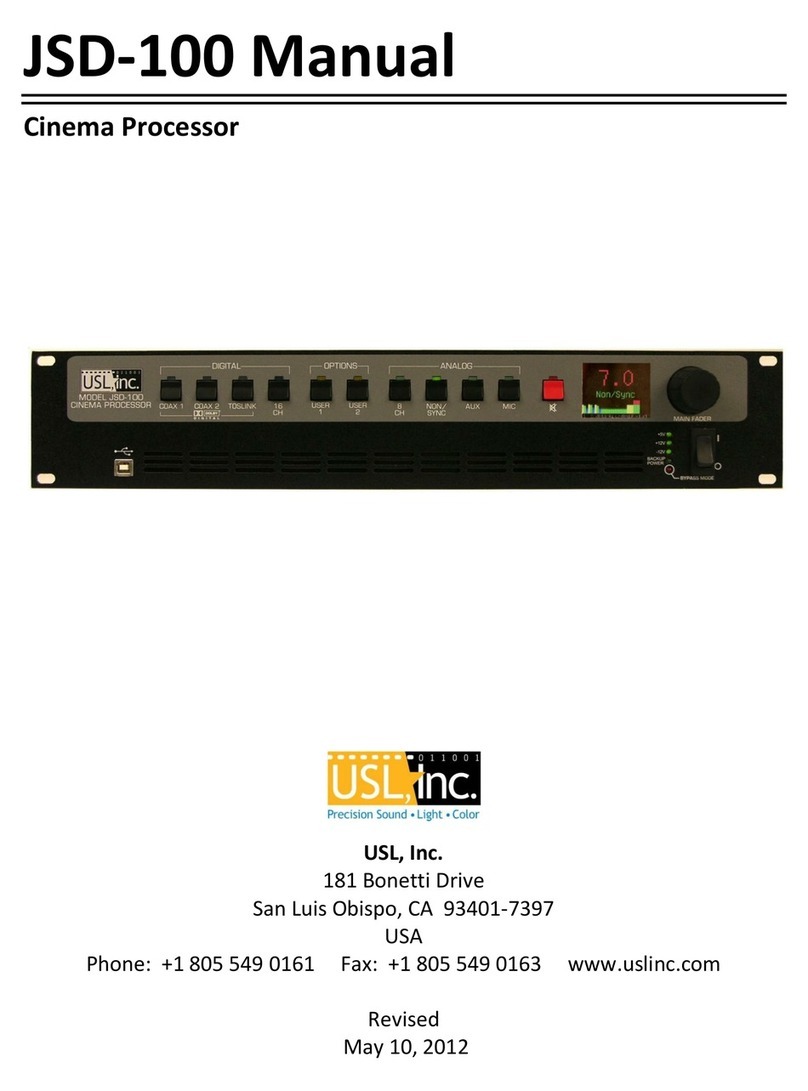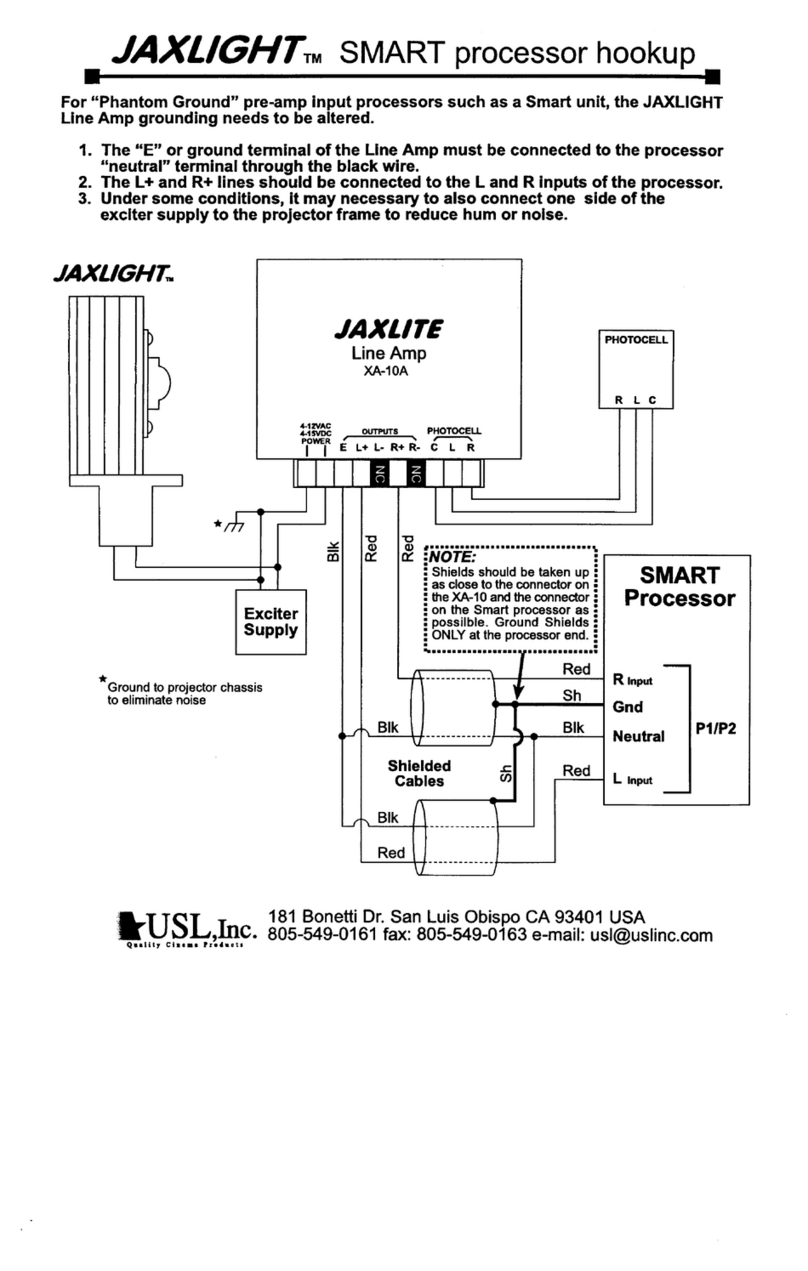
Page 5
N’opérez pas avec les Échecs Suspects. Si vous suspectez il y a le dégât ou mal fonctionner avec ce produit,
appelez l’usine.
N’entreprenez pas Réparation. Seulement une personne du service de l’usine compétente est autorisée pour
réparer ce produit.
N’opérez pas ce Produit Sources de la ChaleurProches. Ce produit ne devrait pas être localisé desources de la
chaleur proches tel que radiateurs, registres de la chaleur, poêles, ou amplificateurs.
Fournissez Ventilation Adéquate. La température dufonctionnement devrait être entre 0° C et 40° C.
L’humidité devrait être 20% et 80%. La méthoderefroidissante est par convection et un ventilateur interne.
Gardez les Surfaces du Produit Nettoient et Sec.
Déconnectez le câble du pouvoir de la source du pouvoir avant de nettoyer. N’utilisez pas de nettoyeurs.
liquides ou de nettoyeurs de l’aérosol Utilisez un tissu humide pour nettoyer.
Ne poussez pas d’Objets Dans Ouvrir de ce Produit.
Jamais objets de l’encart dans le produit à travers ouvertures.
N’opérez pas Dans les Conditions Mouillées ou humides.
N’opérez pas Dans une Atmosphère Explosive.
Prévenez le Répandre des Liquides sur les Composants du Système.
Inspectez le câble du pouvoir et tous les câbles antérieur à usage. Confirmez que le câble du pouvoir et autres
interconnectant câbles sont libres de dégât.
Le Niveau de la sécurité
L’EN 60065 niveau spécifie exigences du dessin de la sécurité qui réduisent ou éliminent le risque de blessure
personnelle à l’utilisateur du produit et personnel du service. Ce produit est conçu et est testé pour satisfaire aux
niveaux de l’Electrotechnical Commission Interna-tional (IEC) Norm Européen (EN) 60065 (Le Niveau pour Matériel
de la Technologie de l’Information qui Inclut le Matériel de l’Affaire Électrique).
Allgemeine Sicherheit-Zusammenfassung Europäisch
Überprüfen Sie die folgend Sicherheit-Vorkehrungen, Verletzung zu vermeiden und Schaden zu diesem Produkt zu
verhindern. Um potentielles Risiko zu vermeiden, benutzen Sie dieses Produkt nur als vorgeschrieben hat und nur
denn der Zweck beschrieb in der Bedienungsanleitung.
Um Feuer und Persönliche Verletzung zu vermeiden:
Benutzen Sie Korrektes Macht-Kabel. Benutzen Sie nur das Macht-Kabel, das bereitgestellt wurde. Stellen Sie
sicher, daß der WECHSELSTROM-Macht-Abfluß in der Nähe vom Produkt gefundenwird und leicht zugänglich
ist.
Benutzen Sie eine Korrekt geerdet Macht-Quelle. Der Macht Versorgung Erde Boden wird durch den Boden-
Schaffner im Macht-Kabel gegründet. Das Po-tential elektrischen Schocks zu vermeiden muß der Boden-
Schaffner korrekt sein.
Beobachten Sie Quelle-Klassen. Risiko von Feuer oder elektrischem Schock zu vermeiden muß de Macht-
Quelle 100 sein-240 VAC 50-60 Hz.
Operieren Sie dieses Produkt mit Irgendwelchen Gehegen nicht, die geöffnet wurden, oder entfernen Sie.
Vermeiden Sie Ungeschützten Schaltkreise. Versuchen Sie, die Macht-Versorgung zu öffnen nicht, weil seine
Sicherheit-Zulassung ungültig gemacht werden würde. Die Macht-Versorgung ist ein nicht-reparierbares
luftdicht verschlossene Gerät.
Operieren Sie mit verdächtigt Mißerfolgen nicht.Wenn Sie verdächtigen, gibt es Schaden oder
Funktionsstörung mit diesem Produkt, rufen Sie die Fabrik.
Versuchen Sie keine Reparatur. Nur eine erzogen Fabrik-Dienst-Person wird ermächtigt, dieses Produkt zu
reparieren.
Operieren Sie dieses Produkt Nahe Hitze-Quellen nicht. Dieses Produkt sollte keine nahe Hitze-Quellen wie
Heizkörper, Hitze-Register, Herde, oder Verstärker gefunden werden.






























